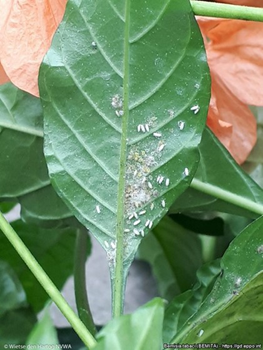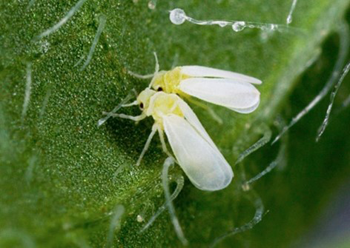PLANT PEST

Gerald Holmes, California Polytechnic State University at San Luis Obispo, Bugwood.org
Exotic begomovirus and vectors (exotic strains and species)
Exotic to Australia, however some strains and vectors are present in Australia
Features: Begomoviruses that destroy a wide range of crops, and the silverleaf whitefly can transmit it from plant to plant
Where they’re from: Begomoviruses like their vector, the silverleaf whitefly are found around the world in Asia, the Americas, Africa and Europe. Australia has only a few of the many strains of begomovirus and some types of silverleaf whitefly
How they spread: Importation of infected plants; importation of the insect silverleaf whitefly that carries the viruses; local spread by insect vectors or transport of infected plants
At risk: Fibre, grain, vegetable and fruit crops including cotton, amaranth, soybeans, beans, cassava, potatoes, tomatoes, chilli, passionfruit, melon and papaya; nurseries
Keep it out
Begomoviruses are a large group of 424 different viruses that can cause a range of devastating plant diseases in many plant species, including important food and fibre crops, such as vegetables, grain legumes and cotton. Infected fields do not produce and the entire crop may be lost. There are hundreds of variations of the virus and nearly all are not present in Australia.
Exotic species of begomoviruses pose a serious risk to Australia’s cotton, vegetable, grain, passionfruit, and melon industries as well as production nurseries.
Australia only has a few types of begomoviruses and it is crucial that we prevent others from infecting our crops.
Among the exotic species that we need to keep out of Australia are:
- cotton leaf curl disease that would devastate Australia’s cotton crops
- mungbean yellow mosaic virus that damages crops of mungbeans and other legumes such as soybean, cowpea and navy beans.
Begomoviruses are spread by the silverleaf whitefly (Bemisia tabaci), a tiny insect that eats over 500 plant species. There are several different types of silverleaf whitefly, a few of which are already present in parts of Australia—in Queensland, New South Wales, northern Western Australia and the Northern Territory —but there are many others that could invade Australia.
The silverleaf whitefly inhabits the underside of plants leaves where it feeds, sucking on plant sap through the leaf. Through this action it also obtains the plant virus that may be present in an infected plant. As silver whiteflies tend to stay in a crop until disturbed with entire whitefly populations known to move from one crop to another during harvesting, disease is easily moved from one crop to another. Once silverleaf whitefly is present it is almost impossible to eradicate.
Importing goods
To keep exotic begomoviruses and silverleaf whiteflies out of Australia, never ignore Australia’s strict biosecurity rules.
Import shipments may need to be treated and certified, so before you import, check our Biosecurity Import Conditions system (BICON).
Stop the spread
There are three biotypes of silverleaf whitely in parts of Australia. All Australians need to follow interstate quarantine restrictions to make sure that the insect vector of begomoviruses does not spread outside Queensland, New South Wales, northern Western Australia and the Northern Territory.
The insect damages plants in its own right, causing stunting and poor growth, and is hard to control with insecticides.
Travellers and people moving interstate
Avoid spreading silverleaf whitefly and begomoviruses by checking Interstate Quarantine rules about what you can and cannot take when you travel within Australia.
What to look for
Symptoms vary depending on the crop and the virus type ranging from leaf curling, stunted plant growth, yellowing of plant tissue and vein thickening. Due to the many symptoms it is often difficult to confirm the presence of begomoviruses without laboratory testing.
Adult silverleaf whitefly:
- is a sap sucking flying insect and is about 1 mm long
- have white wings and yellow bodies, and congregate on the undersides of leaves, they hold their wings vertically tilted, like a peaked roof
- build to very large populations within three to four weeks.

Wietse den Hartog, NPPO the Netherlands, EPPO.

Stephen Ausmus, USDA-ARS, CABI.
Where to look
Importers
Importation of plants cut flowers and cuttings that are infected with the virus or carrying the silverleaf whitefly is the most likely way that begomoviruses could make it to Australia.
Home gardeners
Look for leaf curling, stunted plant growth, yellowing of plant tissue and vein thickening in vegetable plants in the garden. Look on the underside of leaves for the insect.
Growers
Crops should be monitored regularly for any signs of stunted plants with curled leaves and for the silverleaf whitefly.
What to do
If you think you have found begomovirus symptoms, or the silverleaf whitefly outside Queensland, New South Wales, northern Western Australia and the Northern Territory (it has also been recorded in glasshouses in South Australia, Victoria and southern WA):
- take a photo and try to trap the pest in a container or bag
- try not to disturb infested plant material as whitefly tends to stay in a crop until disturbed (this may be as simple as preventing access to a field).
Read the detail
- Plant Health Australia: cotton leaf curl disease fact sheet
- Plant Health Australia: mung bean mosaic virus fact sheet
- Silver leaf whitefly in Australia
- Establish good on-farm biosecurity measures to protect your property. Everything you need to know is available from Farm Biosecurity
- Managing silverleaf whitefly in production nurseries
